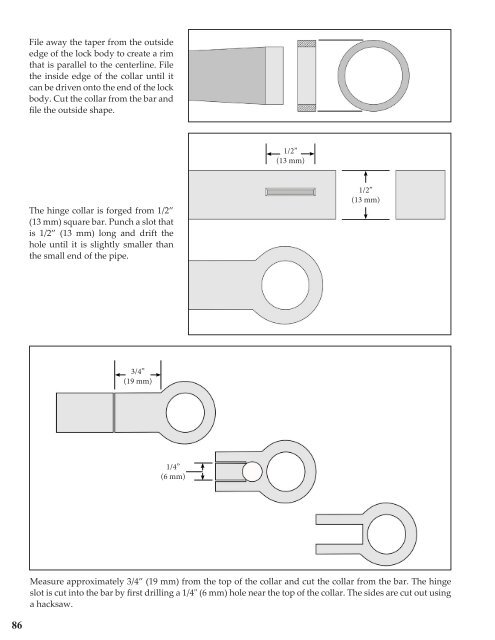The New Spruce Forge Manual of Locksmithing: A Blacksmith’s Guide to Simple Lock Mechanisms
The New Spruce Forge Manual of Locksmithing: a Blacksmith’s Guide to Simple Lock Mechanisms is a totally revised and expanded version of the original work from 1999. This new hardcover edition, at 304 pages and with more than 800 color photos and illustrations, is more than double the size of the original manual. It is divided into two distinct sections: Technical Information - This section is a reference manual in itself that covers the specific tools and techniques needed to build all the parts for each lock, as well as providing the information needed to understand the assembly instructions outlined in the second section. The Locks: Patterns & Instructions - This section provides the plans and detailed instructions for each of the 14 lock projects in this new edition. The clear assembly instructions describe when and how to use the technical information provided in section one. The authors have maintained their original trademark style that relies on well-illustrated step-by-step instructions that guide you through the whole lock-making process. They have also kept their low-tech approach that demonstrates how to go about creating good work using only a handful of simple tools. Making blacksmith locks is an age-old skill the authors of this manual are helping to preserve by passing on their knowledge to this book’s readers. The New Spruce Forge Manual of Locksmithing is also an excellent introduction to benchwork, which is a useful skill for any blacksmith to acquire. This manual will become a valuable, trusted and often referred to sourcebook in your blacksmithing library. Hardcover, 304 pages, more than 800 photos and illustrations.
The New Spruce Forge Manual of Locksmithing: a Blacksmith’s Guide to Simple Lock Mechanisms is a totally revised and expanded version of the original work from 1999. This new hardcover edition, at 304 pages and with more than 800 color photos and illustrations, is more than double the size of the original manual.
It is divided into two distinct sections:
Technical Information - This section is a reference manual in itself that covers the specific tools and techniques needed to build all the parts for each lock, as well as providing the information needed to understand the assembly instructions outlined in the second section.
The Locks: Patterns & Instructions - This section provides the plans and detailed instructions for each of the 14 lock projects in this new edition. The clear assembly instructions describe when and how to use the technical information provided in section one.
The authors have maintained their original trademark style that relies on well-illustrated step-by-step instructions that guide you through the whole lock-making process. They have also kept their low-tech approach that demonstrates how to go about creating good work using only a handful of simple tools.
Making blacksmith locks is an age-old skill the authors of this manual are helping to preserve by passing on their knowledge to this book’s readers. The New Spruce Forge Manual of Locksmithing is also an excellent introduction to benchwork, which is a useful skill for any blacksmith to acquire. This manual will become a valuable, trusted and often referred to sourcebook in your blacksmithing library.
Hardcover, 304 pages, more than 800 photos and illustrations.
Create successful ePaper yourself
Turn your PDF publications into a flip-book with our unique Google optimized e-Paper software.
File away the taper from the outside<br />
edge <strong>of</strong> the lock body <strong>to</strong> create a rim<br />
that is parallel <strong>to</strong> the centerline. File<br />
the inside edge <strong>of</strong> the collar until it<br />
can be driven on<strong>to</strong> the end <strong>of</strong> the lock<br />
body. Cut the collar from the bar and<br />
file the outside shape.<br />
1/2”<br />
(13 mm)<br />
<strong>The</strong> hinge collar is forged from 1/2”<br />
(13 mm) square bar. Punch a slot that<br />
is 1/2” (13 mm) long and drift the<br />
hole until it is slightly smaller than<br />
the small end <strong>of</strong> the pipe.<br />
1/2”<br />
(13 mm)<br />
3/4”<br />
(19 mm)<br />
1/4”<br />
(6 mm)<br />
Measure approximately 3/4” (19 mm) from the <strong>to</strong>p <strong>of</strong> the collar and cut the collar from the bar. <strong>The</strong> hinge<br />
slot is cut in<strong>to</strong> the bar by first drilling a 1/4" (6 mm) hole near the <strong>to</strong>p <strong>of</strong> the collar. <strong>The</strong> sides are cut out using<br />
a hacksaw.<br />
86










